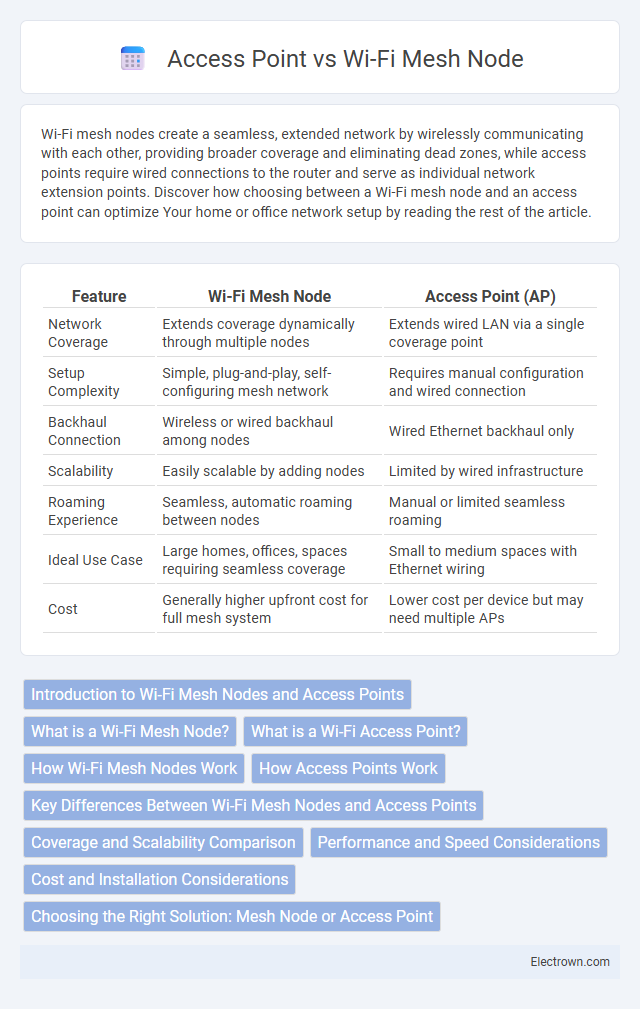Wi-Fi mesh nodes create a seamless, extended network by wirelessly communicating with each other, providing broader coverage and eliminating dead zones, while access points require wired connections to the router and serve as individual network extension points. Discover how choosing between a Wi-Fi mesh node and an access point can optimize Your home or office network setup by reading the rest of the article.
Table of Comparison
| Feature | Wi-Fi Mesh Node | Access Point (AP) |
|---|---|---|
| Network Coverage | Extends coverage dynamically through multiple nodes | Extends wired LAN via a single coverage point |
| Setup Complexity | Simple, plug-and-play, self-configuring mesh network | Requires manual configuration and wired connection |
| Backhaul Connection | Wireless or wired backhaul among nodes | Wired Ethernet backhaul only |
| Scalability | Easily scalable by adding nodes | Limited by wired infrastructure |
| Roaming Experience | Seamless, automatic roaming between nodes | Manual or limited seamless roaming |
| Ideal Use Case | Large homes, offices, spaces requiring seamless coverage | Small to medium spaces with Ethernet wiring |
| Cost | Generally higher upfront cost for full mesh system | Lower cost per device but may need multiple APs |
Introduction to Wi-Fi Mesh Nodes and Access Points
Wi-Fi mesh nodes create a unified wireless network by communicating with each other to extend coverage seamlessly throughout your home or office, eliminating dead zones. Access points connect to a wired router and provide Wi-Fi access to specific areas, expanding the network range but requiring separate network names or manual switching. Understanding these fundamental differences helps you optimize your Wi-Fi setup for consistent speed and coverage.
What is a Wi-Fi Mesh Node?
A Wi-Fi mesh node is a device that extends a wireless network by connecting to other nodes, creating a seamless mesh network with consistent coverage and improved signal strength. Unlike traditional access points, mesh nodes communicate dynamically with each other to optimize data paths and reduce dead zones. This technology enables scalable and flexible network expansion without relying on wired backhaul connections.
What is a Wi-Fi Access Point?
A Wi-Fi Access Point (AP) is a networking device that extends a wired network by providing wireless connectivity to devices within a specific area, acting as a bridge between wired and wireless networks. It enables multiple devices to connect to the internet or a local network by transmitting and receiving Wi-Fi signals. Unlike Wi-Fi Mesh Nodes, which work together to create a seamless wireless network, a single access point typically relies on a centralized router and offers coverage limited to its immediate vicinity.
How Wi-Fi Mesh Nodes Work
Wi-Fi mesh nodes create a wireless network by connecting multiple devices that communicate with each other to extend coverage seamlessly across a large area. Each node acts as a router, dynamically routing data among nodes to optimize signal strength and reduce dead zones. This decentralized system contrasts with traditional access points, which rely on a single main router and wired connections to extend the network.
How Access Points Work
Access points extend a wired network by creating additional wireless coverage zones, connecting directly to routers or switches through Ethernet cables. Each access point broadcasts its own Wi-Fi signal, allowing devices to roam seamlessly without losing connection within a larger network. Unlike mesh nodes that communicate wirelessly with each other, access points rely on wired backhaul to maintain high-speed, stable connectivity.
Key Differences Between Wi-Fi Mesh Nodes and Access Points
Wi-Fi mesh nodes create a seamless, self-healing network by communicating with each other to extend coverage, while access points connect directly to a wired router to expand Wi-Fi reach without forming an interconnected system. Mesh nodes offer dynamic routing and automatic load balancing, improving network reliability and reducing dead zones, whereas access points rely on a single network backbone and may require manual configuration. Your choice depends on whether you need scalable, flexible coverage or a simpler, cost-effective solution for a fixed area.
Coverage and Scalability Comparison
Wi-Fi mesh nodes offer superior coverage by creating a seamless wireless network that dynamically routes data through multiple nodes, effectively eliminating dead zones in large or multi-story environments. Access points expand coverage by connecting to a central router, but their range is limited to the strength of the single connection and may require wired backhaul for optimal performance. Mesh systems scale efficiently by simply adding nodes without complex configuration, whereas access points often require manual network adjustments and additional wiring as the network grows.
Performance and Speed Considerations
Wi-Fi mesh nodes distribute data across multiple units, reducing dead zones and maintaining consistent speeds throughout large or multi-story homes. Access points rely on a wired connection to the main router, often delivering higher raw speeds but potentially creating coverage gaps without additional hardware. For maximizing performance and speed, mesh systems excel in seamless coverage, while access points offer superior throughput in densely wired environments.
Cost and Installation Considerations
Wi-Fi mesh nodes generally have higher upfront costs than traditional access points due to their advanced technology and ease of scalability for larger areas. Installation of mesh nodes is simpler, involving plug-and-play setup without extensive wiring, making them ideal for expanding coverage seamlessly. Access points may require professional installation and additional Ethernet cabling, increasing both installation complexity and expenses in comparison to mesh systems.
Choosing the Right Solution: Mesh Node or Access Point
Choosing the right solution between a Wi-Fi Mesh Node and an Access Point depends on your network size and coverage needs. Mesh Nodes create a seamless, self-healing wireless network ideal for large homes or offices with multiple floors, while Access Points extend signal in specific areas by connecting directly to your router via Ethernet. To optimize your Wi-Fi performance, evaluate your space layout and internet usage to decide whether the flexibility of a Mesh Node or the targeted reach of an Access Point best suits your setup.
Wi-Fi Mesh Node vs Access Point Infographic

 electrown.com
electrown.com